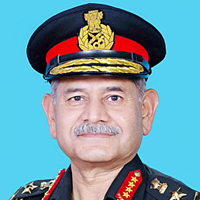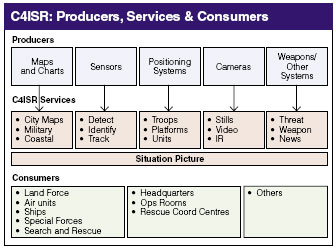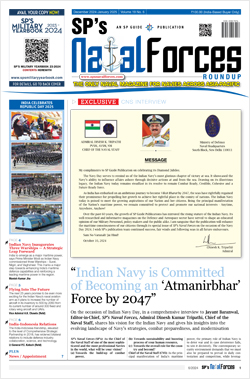INDIAN ARMED FORCES CHIEFS ON OUR RELENTLESS AND FOCUSED PUBLISHING EFFORTS

The insightful articles, inspiring narrations and analytical perspectives presented by the Editorial Team, establish an alluring connect with the reader. My compliments and best wishes to SP Guide Publications.

"Over the past 60 years, the growth of SP Guide Publications has mirrored the rising stature of Indian Navy. Its well-researched and informative magazines on Defence and Aerospace sector have served to shape an educated opinion of our military personnel, policy makers and the public alike. I wish SP's Publication team continued success, fair winds and following seas in all future endeavour!"

Since, its inception in 1964, SP Guide Publications has consistently demonstrated commitment to high-quality journalism in the aerospace and defence sectors, earning a well-deserved reputation as Asia's largest media house in this domain. I wish SP Guide Publications continued success in its pursuit of excellence.
- MoD initiates comprehensive review of Defence Acquisition Procedure 2020, pushes for defence reforms
- G7: The Swansong
- Kalinga Connect: South Asia to Polynesia
- Advanced MRSAM for India for a greater firepower
- Must Credit DRDO for Operation Sindoor, now what is next for defence R&D?
- Operation Sindoor | Day 2 DGMOs Briefing
- Operation Sindoor: Resolute yet Restrained
System Analysis
Conceptual Underpinnings

Service-based C4ISR solutions for net-centric defence have several distinct benefits that enhance and improve operational capabilities
The value chain in a network centric environment com-prises of several layered concepts:
• Data Quality is at the most funda-mental level and describes the infor-mation within the underlying command and control systems.
• Information Quality indicates the completeness, correctness, currency, consistency, and precision of the data items and information statements.
• Knowledge Quality deals with procedural knowledge and information embedded in the command and control system such as templates for adversaries, assumptions about entities such as ranges and weapons, and doctrinal assumptions, often coded as rules. In the more evolved systems, this component would comprise more and more of modeling and simulation systems. Knowledge quality is the first component related to the common model of the operation.
• Awareness Quality measures the ability to use the information and knowledge embed-ded within the command and control system. Awareness lies in the cognitive domain that is at a level that is above the level of technical interoperability.
Efficient conduct of operations is enabled by the ability to share data, information, knowl-edge and awareness. In other words, the IT value chain accompanies the network-centric value chain. Significantly, this is reflected in improvements in command, control, commu-nications, computers, information, surveillance and reconnaissance (C4ISR) over the recent decades. C4ISR systems initially started as database centric and message driven solu-tions, only able to support Data Quality. To progress to the next level, the idea of the Common Operational Picture (COP) was introduced, thereby improving not only Data Quality, but also Information Quality.
Modelling and simulation abilities in a C4ISR system add procedural knowledge in the form of models. Such a system can thus support the next level in the value chain, trig-gering further improvements. Evolving further, the ability to use this information, as distinct from understanding it, is aided by the system’s ability to mine, analyse and present data for decision support and this is pertinent in the Awareness Quality context. The underlying fact of course is that it is far more necessary to bridge the cultural gaps rather than the techni-cal gaps to make this vision become reality. Interoperability aspects of networks come to fore, if robust defences are to be built in.
Service Oriented Architecture
Increasingly, C4ISR solutions for network-oriented defence are based on a Service-Oriented Architecture (SOA) where the functionality of a system is made available as services that can be accessed by any autho-rised user connected to the network, mobile or stationary. This makes it possible to avoid large “stovepipe” systems, designed only for a specific purpose, and instead make it possible to combine individual systems into systems-of-systems. Even geographically distributed systems can then be used as modular build-ing blocks that are interconnected and can be combined in different ways. The two key categories are Services and Infrastructure. Services pertain to services for Communication and Collaboration, Situation Information, Information Operations, Command and Control and Engagement Support. Infrastructure includes a Control Layer, a Convergence Layer and a Connectivity Layer.
The Communication and Collaboration ser-vices provide functionality for communication and information sharing. Situation Information services involve gathering, processing and dissemination of situation information. Information Operations include services for assessment and influence on other parties’ situation information and also for protection of the own situation information. Command & Control involves services for decision support and order handling. Engagement systems and effectors are connected to the C4ISR environ-ment and are involved in the information flow and controlled by Engagement Support ser-vices. The Control Layer contains functionality and support services that are used to give all the services mentioned above the required characteristics and features such as security, mobility, and accessibility. The Convergence Layer ensures that connectivity can be accom-plished in a unified manner based on the Internet Protocol (IP) and different types of fixed and wireless networks, belonging to the Connectivity Layer can be used.
Distributed System-of-Systems
The C4ISR system is to be regarded as a dis-tributed system-of-systems with each system producing and/or consuming services. The producers and consumers of various functions are separated. Thus, services are not neces-sarily produced for a single particular purpose and their production is independent of the consumers. This also means that services and information reside in the system as a whole, integrated and aggregated, thereby creating services and information with a higher value.
Further, infrastructure and/or technical systems producing the services need not be new and existing legacy systems can be integrated. Finally, systems are scalable and hence services and capabilities can be further developed in an evolutionary fashion.
Communication Network
In keeping with the system-of-systems approach, the best, and often the most practi-cal option, is a network-of-networks, utilising a variety of communication technologies. These are also called heterogeneous communication networks. Communication networks may have different origins: public, private, defence, gov-ernmental and so on, and may include tactical radio, broadband networks, fixed telephony, and mobile networks. The trick is to use the IP as the common communication protocol.
Dedicated non-IP networks may, however, be necessary in situation and applications where real-time information is critical. The network-of-networks approach puts special requirements on infrastructure functionality, like routing, addressing, mobility, quality of service and security. These can be based on commercially available technologies with additional security, robustness, and flexibility requirements as deemed necessary; as they can be cost efficient and make use of the most advanced compo-nents and technologies available. For example, GSM and CDMA based systems can be used in many applications. The main advantages of the network-of-networks approach are:
• Improved efficiency and a reduction of equip-ment and operational costs. Ability to dynami-cally compose networks depending upon where network resources are needed for the moment.
• Much higher redun-dancy since even if one equipment is damaged, others continue to operate and joint communications are maintained using alternative paths. Even if all inter-network connec-tions are lost, sub-net-works are formed that can later be reconnected.





